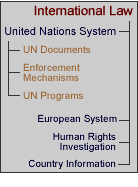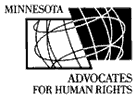UN Human Rights Committee
The Human Rights
Committee is the UN body that monitors State compliance with and enforces
the International Covenant on Civil and Political
Rights. The Committee consists of 18 experts who meet three
times a year.
States that
have [ratified] [link to country pages] the International Covenant on Civil
and Political Rights are required to submit period reports documenting compliance
with the provisions of the treaty. The Committee holds a dialog with the
State representatives to obtain specific information about whether State laws
and practices are in conformity with the Covenant. The UN has made clear
that the review process is not adversarial, and the role of the Committee
is not to pass judgment, but rather to facilitate the process of bringing
State parities in line with the provisions of the International Covenant on
Civil and Political Rights. The Committee prepares concluding observations,
which may include recommendations for specific measures to be taken.
The first Optional
Protocol to the International Covenant on Civil and Political Rights allows
individuals, who are from countries that have ratified these two documents,
to bring complaints of human rights violations.
By ratifying
the International Covenant on Civil and Political Rights, State parties undertake
to ensure that women and men enjoy all civil and political rights equally.
Additionally, article 26 of the International Covenant on
Civil and Political Rights guarantees that all people are equal before the
law and are therefore entitled to equal protection of the law without discrimination.
Thus, national laws must guarantee equal and effective protection against
discrimination. The Human Rights Committee has held that article 26 “prohibits
discrimination in law or in fact in any field regulated by public authorities
and that the scope of article 26 is not limited to civil and political rights.”
Women have, therefore, used article 26 to challenge discriminatory laws that
do not necessarily relate to civil and political rights, such as discriminatory
distribution of social security.
In cases of
violence against women, it may be possible to base a claim of unequal access
to the legal system under the International Covenant on Civil and Political
Rights. The Division for the Advancement of Women has created a webpage that
lists sample Cases
Where Women Have Used the First Optional Protocol to the ICCPR to challenge
sex discrimination.
The complaint
and reporting mechanisms available under the Human Rights Committee are summarized
below.
Complaint Mechanism- First Optional
Protocol to the International Covenant on Civil and Political Rights
Type of Mechanism |
Complaint- recourse procedure under
the first Optional Protocol to the International Covenant on Civil and
Political Rights (CCPR) |
| Scope of the Procedure |
The rights enumerated in the CCPR, specifically
the prohibition on sex-based discrimination |
| Who can Submit a Complaint? |
Individuals of states which have ratified
both the CCPR and the Optional Protocol to the Covenant |
| Role of Advocates |
Only individuals can submit complaints
under the Optional Protocol, however, advocates can play a role in the
process, from providing advice to the individual complainant to submitting
communications to the Committee about the case, and monitoring State
compliance with the Committee’s decision. |
| Available Remedies |
The Committee adopts a “view“ or
decision on the case, which can be a finding that a State has violated
the CCPR.
The views of the Committee are made public and can include recommendations
to the national government to take specific actions to protect an individual
or provide redress. Then, the Committee monitors State compliance with
its decision to determine if the State has provided an appropriate remedy.
The Committee may address an urgent request to a State, asking
for interim protection for the victim while the case is being decided. |
| How to Submit a
Complaint
|
Individuals who claim to be victims of
human rights violations by a State party can submit communications.
The Committee has created a Model
Complaint Form for communications under the Optional Protocol to
the CCPR.
In addition, the Protocol sets for a number of admissibility
criteria, which must be met for the complaint to be considered:
The complaint must be in writing.
The communication may not be anonymous.
The complaint must concern a State party to the Protocol.
The complaint should contain information about the exhaustion
of domestic remedies.
The complaint cannot have been previously examined by the Committee
or be the subject of any other international investigation.
The subject of the complaint must indicate a violation of the
provisions of the International Covenant on Civil and Political Rights.
|
| Where to Send Communications |
The Human Rights Committee
c/o Office of the High Commissioner for
Human Rights
United Nations Office at Geneva
1211 Genève 10
Switzerland
Tel: + 41 22 917 9000
Fax: + 41 22 917 9003 |
| How the Complaint Procedure Works |
The review of individual complaints proceeds
in three stages:
(1) Pre-admissibility- the communications are screened to determine
whether they raise issues under the CCPR. Once the complaint has been
declared preliminarily admissible, the compliant is forwarded to the
State which has 2 months to respond. The author of the complaint is
then allowed to submit additional comments.
(2) Admissibility/ Inadmissibility- a working group of the Committee
meets before the session to declare the case admissible or inadmissible,
based on issues of exhaustion of domestic
remedies, whether the claim
is already under review and whether the claim is substantiated.
(3) Consideration of the case- if the case is deemed admissible,
the State has 6 months to explain the allegations and present information
about whether the violation has been remedied. The complainant has
6 weeks to present a reply to the State’s communication. After reviewing
all communications, the Committee makes a decision (referred to as “views”).
Consideration of communications is confidential and carried out in closed
sessions, but the Committee decision is sent to the State, the complainant
and made public.
Because the process from the submission of a complaint to the
examination of the merits can take over two years, before making a decision
on the merits of the case, the Committee may request that a State adopt
immediate measures to protect a victim temporarily. |
| Advantages/ Disadvantages |
Individuals have a formal role in the
complaint/ communications process. The Committee decisions are made
public, which may be important for advocacy, but may not be in the victim’s
best interests. |
Adapted in part from Women’s Human Rights Step
by Step, Women Law & Development International and Human Rights Watch
Women’s Rights Project (1997).
Additional Resources
General Information on the Human
Rights Committee can be found on the UN website.
Information about the complaint mechanism under the First
Optional Protocol to the International Covenant on Civil and Political
Rights is also available on the UN site.
Frontline, an Irish NGO, has created a Human
Rights Defenders Manual, which includes detailed information on submitting
complaints to the Human Rights Committee in cases of specific human rights
violations.
Reporting Mechanism- Human Rights Committee
Type of Mechanism |
Reporting and Monitoring |
| Scope of the Procedure
|
The rights enumerated in the International
Covenant on Civil and Political Rights |
| Who can Submit a Report |
NGOs only |
| Role of Advocates |
NGOs can submit “shadow” or alternative
reports to country reports, to the Committee as a whole or to individual
members. NGOs with UN accreditation can also monitor the Committee
proceedings during State reporting periods. |
| Available Remedies |
No remedies for individual rights violations.
|
| How to Submit
a Report |
There is no single format for shadow
reports, but the report should be organized according to the articles
of the Covenant and as a commentary on the State party report. A shadow
report should analyze a particular problem rather than merely describe
it.
More information on writing shadow reports, using shadow reports
strategically and sample NGO reports can be found in the Human Rights
Investigation and Documentation section of this website. |
| Where to Send Communications |
The Human Rights Committee
c/o Office of the High Commissioner for
Human Rights
United Nations Office at Geneva
1211 Geneva 10
Switzerland
Tel: + 41 22 917 9000
Fax: +41 22 917 9003 |
| How the Reporting Procedure
Works |
After ratifying the Covenant, State parties
are required to submit an initial report on compliance. States must
then submit periodic reports every five years and at the Committee’s
request.
The Committee normally meets three times a year to review the
periodic reports
There are no deadlines for submitting shadow reports, but NGO
submissions are most useful to the Committee at the time that a specific
State is reporting. It is advantageous to allow Committee members enough
time to review the submission, for example a few months before the session
date.
The sessions in which the Committee reviews State reports are
open to the public. There is no specific procedure to allow the Committee
to consider outside information, but NGOs have been invited to offer
comments on the reports. Committee members rely on information from
a variety of source in their dialog with State representatives, including
from other UN bodes and from NGOs.
Once the Committee has reviewed the reports, it issues comments
and recommendations. |
| Advantages/ Disadvantages |
NGOs have used shadow reports effectively
to advocate for change. Periodic State
reporting has put pressure on national governments to amend legislation
and policies to bring them into compliance with the Convention. Individuals
cannot submit information to the Committee. There are no enforcement
mechanisms applicable to States that do not submit periodic reports. |
Adapted
in part from Women’s Human Rights Step
by Step, Women Law & Development International and Human Rights Watch
Women’s Rights Project (1997).
Additional Resources
General Information on the Human
Rights Committee can be found on the UN website. This page includes the
Rules of Procedure for the Human Rights Committee, State party reports and
the Committee’s concluding observations.
More information
on writing shadow reports, using shadow reports strategically and sample
NGO reports can be found in the Human Rights Investigation and Documentation
section of this website.

